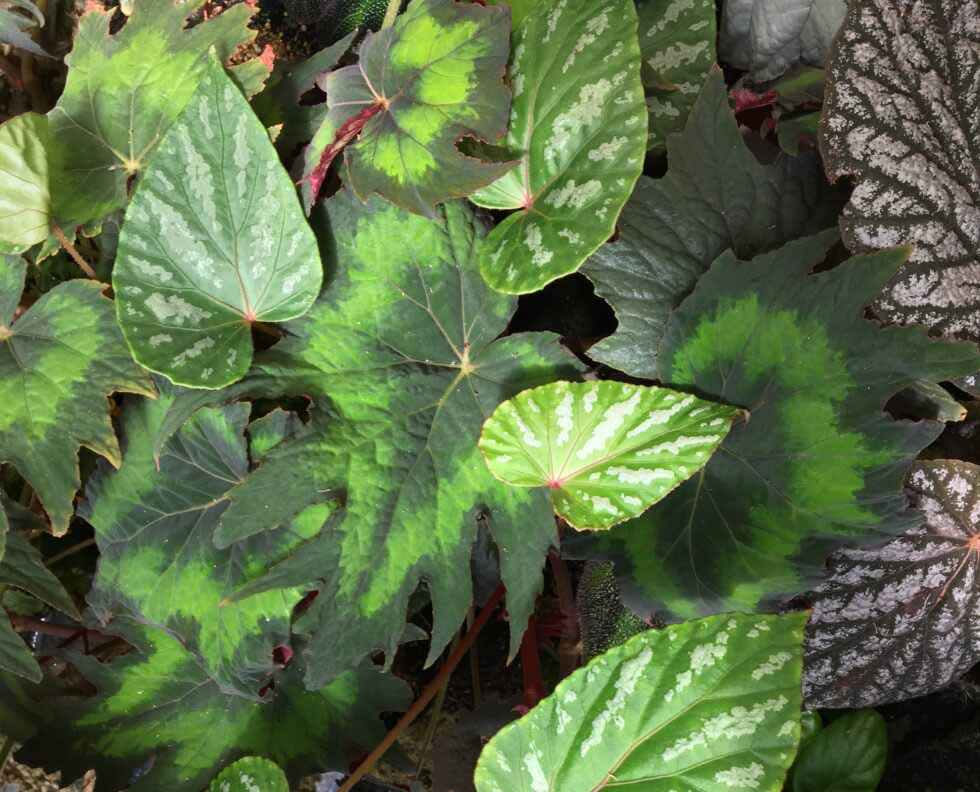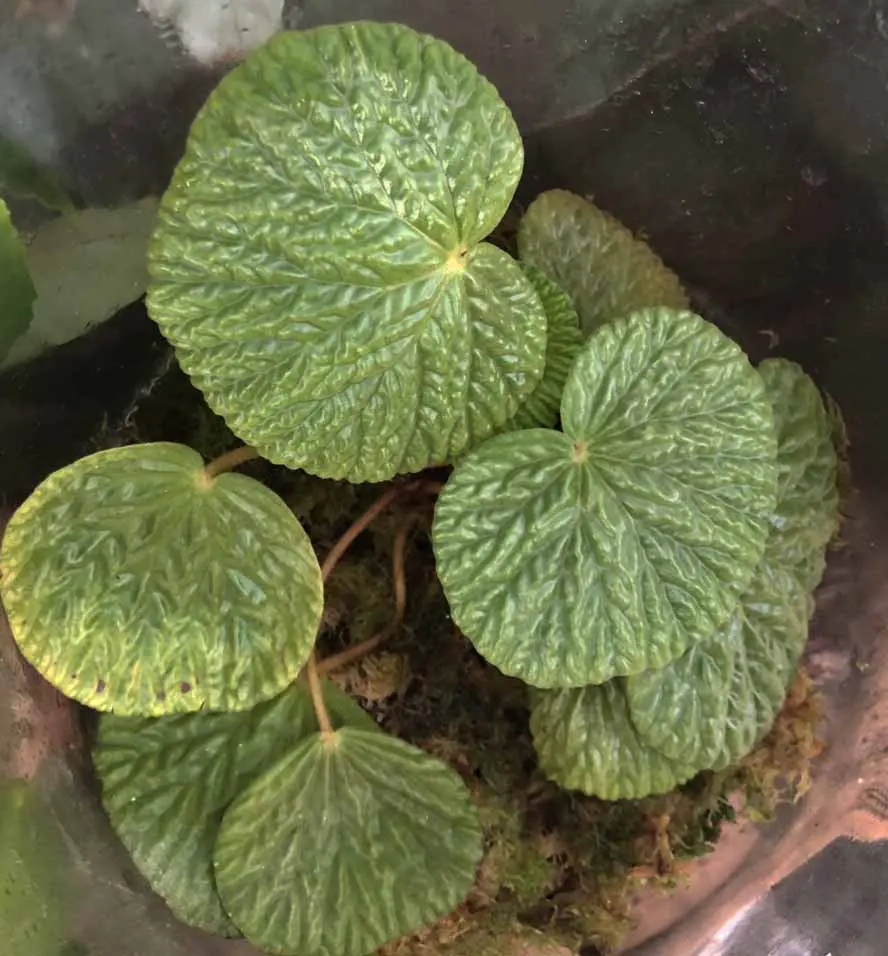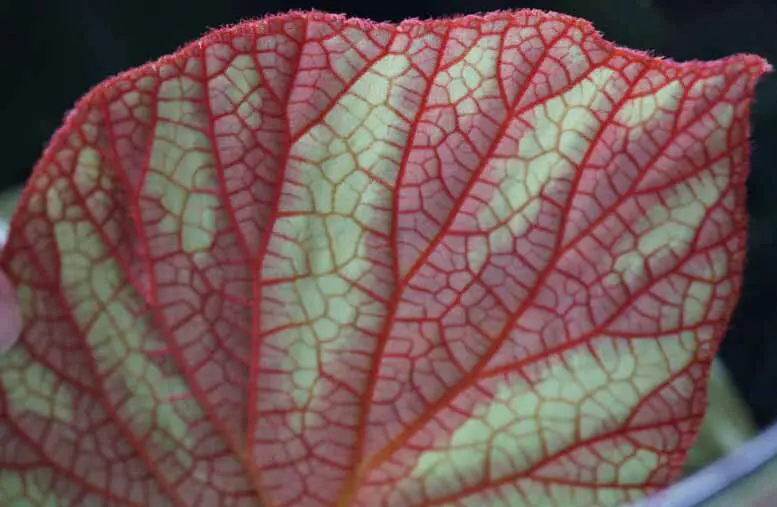Species begonias are begonias that grow in the wild somewhere in the world. There are several hundred species of begonias in the world, many still waiting to be discovered. Many species of begonias have been in cultivation for a few hundred years however. They come in the full range of cultural requirements. Some are nearly indestructible and some may require terrarium care.
Unlike hybrid begonias, which were developed specifically for our gardens and homes, species begonias evolved over eons to adapt to the specific climate where they live. Many can be a challenge to grow but nearly all species can be grown if you keep in mind their native habitat.
Species begonias also have a plus in their favor in that they can be grown true from seed unlike the hybrids which must be propagated by cuttings. (note of interest; the word species is both singular and plural. One plant is a species and a group of species are species. There is no specie. I’ve commonly seen someone say “I have a Begonia specie” but correctly it should be “I have a Begonia species”.)
The Importance of Growing Species
Just like tigers and other endangered animals, begonias are also endangered in the wild as their habitat is being destroyed. Some species are so specialized that they only grow in a single valley in some tropical area. It’s important to include species in your Begonia collections in order to keep them from becoming extinct. Many species only exist in cultivation and are already extinct in the wild. It’s only due to dedicated Begonia enthusiasts that many species are still around.
Not all species are beautiful or make pretty plants but each has genetic traits that may be important in the future. There are beautiful species to be sure. Some of the most beautiful begonias are species that rival even the most spectacular hybrids. All the species are special and need to be preserved to the best of our ability. Even the plainer species can fill niches in our yards and homes where other begonias might not do well.
Responsibilities of Growing Species
Many Begonia growers grow numerous species of begonias and treat them like all their other begonias. They just enjoy them. Although enjoying them is part of the reason for growing them you should take a more responsible approach. The following is a list of suggestions for growing species responsibly if your aim is to help keep them in cultivation and save them from extinction.
1. Names
You should make every effort to make sure your species are properly identified and named. Improperly or misnamed species being circulated doesn’t help in their preservation. It only adds an element of confusion. If you have a species that can’t be identified don’t circulate it to others until you can identify it at some later date. Make sure you stay as current as possible as to name changes for species you may have. Many species have been given several names by mistake and it’s an ongoing project to determine their proper names. Make sure the spelling of your species name is correct and make sure that when shared with others, those are properly labeled also.
2. Sharing & Conserving Your Species
If you have species begonias in your collection, make a concerted effort to share them with others. Keeping rare plants to yourself will only come back to haunt you in the end. If you lose your one of a kind or rare species, you’ll have no one to get it back from if you didn’t share. So, if for no other than selfish reasons, you should always share. Make especially sure to share them first with people who are good growers, people that will keep them labeled correctly, and people that will continue the sharing. Make a concerted effort to propagate new plants of all your species so you have duplicates. This will give you a backup for when you lose one and you’ll also have the extras around to share with friends. When you start plants for club sales, don’t forget to start plants of your species for those also.
3. Grow Some of the Plainer Species
Make room in your collection for some of the less exciting species. You don’t have to give them your prime areas. Everyone has a corner or out of the way spot. Tall rangy growing species can be used as background plants even. Besides, even some of the plain ones may surprise you with awesome flowers you weren’t expecting. You might even find they work in an area where you’ve had trouble growing other begonias. If you do hybridizing, you may also find that some of the plainer species have desirable traits you can use.
4. Watch for New Species
Try to add new species to your collection as you find them at various sales and other people’s homes. You can also acquire new species by finding and growing seed. This is an inexpensive way to add to your collection and also have extra plants to share. Try to make finding species and preserving as many as you have room for a personal goal.
5. Get Others Involved
Make an attempt to get other Begonia growers interested in growing species. Getting others interested will help keep you interested. This can be as involved as you want, any involvement is better than none. It can be as simple as just suggesting to friends that they grow species to as involved as joining a species preservation group or starting your own.
6. Keep a List
Make a concerted effort to always keep an updated list of the species in your collection. This will help you keep track of what you have. It will also help in being able to let others know which species you’re growing and preserving. By sharing and comparing your list with other grower’s lists it will help provide a basis for knowing what species are in cultivation. You may find that some species you’ve been growing for years and thought common is the only one. There have been many efforts in the past to build a database of species, growers and locations. These efforts have largely failed because growers don’t keep a list that can be shared with anyone trying to compile the information. Only list plants that are correctly identified positively and that you’ve been growing long enough to know you can keep them in cultivation, at least for sharing with others.
7. Set Seed
Setting seed on your species begonias is one of the most important things you can do to help preserve them. This seed can later but used for various seed banks and seed funds to help preserve and circulate species. It doesn’t take a large amount of effort to self-pollinate a few flower clusters on your species when they’re in bloom. They do need to be hand pollinated however to assure that any seed created is pure. Flowers pollinated on species by insects or wind may not be pure. Although all Begonia growers should belong to The American Begonia Society, if you don’t, you can still donate your seed to their seed fund. The address and info for sending and setting seed will follow later in this chapter.
8. Show Your Species Begonias
If you live in an area where there are begonias clubs that have local shows, enter some of your species. This is a good way to get other Begonia growers interested in growing the species. It also lets people see the charm and diversity of species begonias. Species commonly win best in show at Begonia shows because many can be a challenge to grow as a “show” plant. There are just as many that aren’t a challenge though and besides showing is the important part, not whether you win anything.
9. For the Dedicated
If you want an extra challenge that takes a little more dedication, keep a notebook on your species. Many species have very little written down about them and any information you keep track of on your species could be helpful to other growers. You can also include in this notebook information you gather from other sources as a reference for yourself.
Creating, Finding, and Sharing Seed
Creating Seed
Creating seed on species begonias is a reasonably simple process. For specific or a more detailed description refer to All Things Seed. Species need to be hand pollinated to ensure the seed is true to the species. Seed formed by mother nature could be natural hybridizing so that seed shouldn’t be collected. Hand pollinating a species with pollen of the same species is called selfing. Selfing is short for self-pollinating.
Ideally it’s best to use pollen from another plant of the same species than to use the pollen off the same plant. If you only have the one plant of the species, then using it’s own pollen is still acceptable. The reason for using two different plants if possible is for genetic diversity. Although species come true from seed, each plant does have minor genetic differences. Just like with animals, it’s better not to inbreed if it can be avoided. In can result in weaker strains of species or give rise to mutations. Selfing a species with the pollen from the same plant is however better than not doing any selfing. When selfing, try to pollinate several clusters of flowers so that you collect a good supply of seed to share at the end of the process.
Finding Seed
Although various seed catalogs do carry a limited amount of some species, the mostly likely sources are fellow Begonia growers and The Clayton M. Kelly Seed Fund. The seed fund is only available to members of The American Begonia Society. If you aren’t currently a member, if you’re interested in finding Begonia seed, it’s well worth the membership fee just to have access to the seed fund. You’ll find that by sharing your seed with other growers, they’ll be even more willing to share species seed with you also. Other species growers are a valuable source.
Sharing Your Seed
The best place to share your seed is the Clayton M. Kelly Seed Fund. You don’t have to be a member of ABS in order to donate your seed to the fund. They will accept all donations of species seed.
To donate seed to the fund, see instructions on the Seed Fund Page.
Collecting and sending seed is a fairly simple process. After collecting the seed pods of your species, allow them to dry thoroughly. They are ready to collect once the stems that attach the pods to the plant have started to shrivel up or the pods have started to turn brown. If you take them sooner than this, they won’t be developed enough. If you wait longer the pods may dry fully and release their seed before you get them collected. I put my seed pods in open film canisters or medicine bottles to finish drying.







